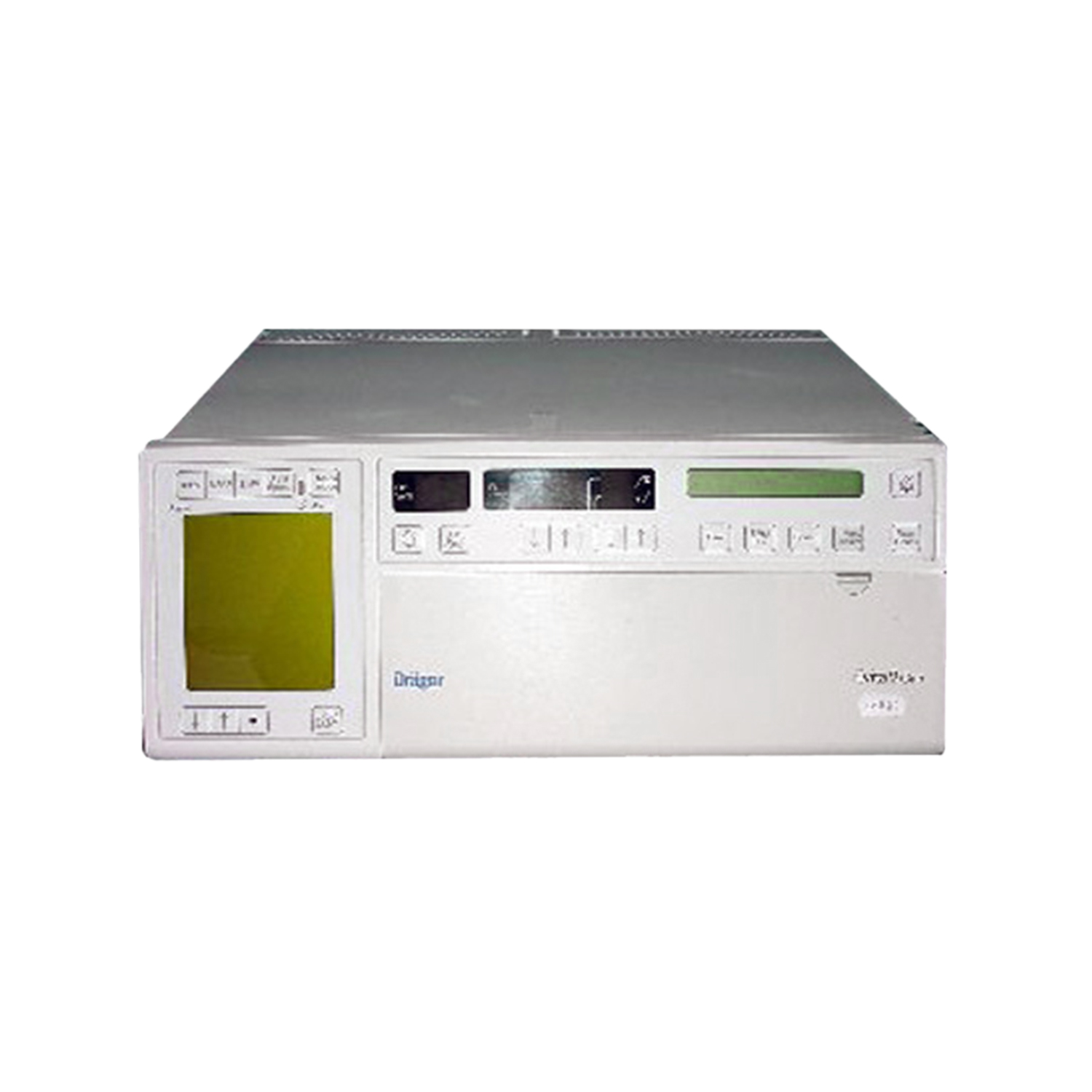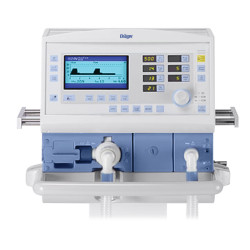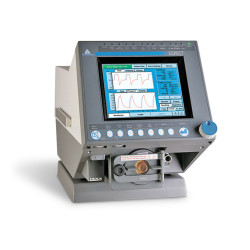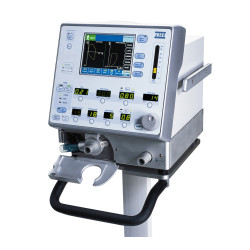Drager Evita 2 Ventilator

Drager Evita 2 Ventilator
0 Artículo está en su carrito Ver carrito ahora
Términos y Condiciones del Listado
All product and company names are trademarks of their respective holders. Use of them does not imply any affiliation with or endorsement or sponsorship by them.
Details
The Evita 2 dura critical-care ventilator maintains high standards of ventilation therapy
Spontaneous breathing strategy
One of Evita 2 dura's strengths is its implementation of our "Room to Breathe" concept. Spontaneous breathing reduces the risk of atelectasis and improves the ventilation/perfusion ratio by maintaining a higher functional residual capacity. BIPAPTM*/PCV+, the universal mode for ventilation and weaning, gives a patient the freedom to breathe spontaneously at any time. AutoFlow®, the next step in volume-oriented ventilation, encourages spontaneous breathing in all volume modes and another option, Automatic Tube Compensation (ATC), gives a patient the feeling of virtual extubation by eliminating the work involved in breathing with a tracheal tube.
The right mode for every patient
Since an Evita 2 dura can be used to ventilate neonatal, pediatric or adult patients, it is the ideal "workhorse" for everyday clinical routine. The wide range of patients covered also reduces the amount of staff training required and ensures a greater flexibility in the use of resources.
Two-in-one ventilation
Mask ventilation can assist the weaning process by reducing the reintubation rate or even preventing intubation in the first place. The option of mask ventilation (NIV) adds to an Evita 2 dura's versatility so an ICU only requires one device for conventional and non-invasive ventilation.
Everything in view
The Evita 2 dura provides patient and ventilator-related monitoring with user interaction reduced to a minimum. The high-resolution full-color screen displays comprehensive information on a patient's status, always showing two ventilation curves and six monitored values, and the screen configuration can be customized to show the most important values for a particular ICU.
One knob, simplified settings
This ventilator has a clearly arranged front panel consisting of a monitoring screen and various setting soft keys. The rotary knob plays a key role. The active setting parameters are visible at a glance and changes can be made by the well-established "select-adjust-confirm" principle.
Ventilation at a glance
The principle of only showing the necessary parameters reduces the complexity of everyday monitoring. Additional functions are located in the various screen menus. The ventilator provides you with a full-text message in the event of alarms so you have a clear idea of the problem.
Simpler and speedier standard procedures
The Evita 2 dura contains numerous functions to speed up and simplify routine procedures. Start-up settings can be configured to specific ICU practices. Suction procedures are simplified with the touch of a button, the exhalation valve can be changed in seconds to minimize downtime and sensors are automatically calibrated daily. However, manual calibration is also possible without interruption to ventilation. All these functions assist in reducing time for standard procedures.
Specifications
Physical Weight & Dimensions
- Height: 11.4 inches (290 cm)
- Width: 20.9 inches (530 cm)
- Depth: 17.7 inches (450 cm)
- Weight: Approx. 27 kg (60 lbs.)
- Diagonal screen size: 6.5" TFT LCD color display
Ventilation Settings
- Ventilation mode:
- IPPV, IPPVAssist (CMV, CMVAssist)
- SIMV, SIMVASB (SIMV, SIMV/Psupp)
- MMV, MMVASB (MMV, MMV/Psupp)
- BIPAP1), BIPAP1)ASB, BIPAP1)Assist (PCV+, PCV+/Psupp, PCV+Assist)
- CPAP, CPAPASB (CPAP, CPAP/Psupp)
- APRV (optional)
- ILV (optional)
- Enhancements
- AutoFlow™ – Automatic adaptation of inspiratory flow in volume controlled modes
- ATC™ – Automatic Tube Compensation (optional)
- IV - Mask Ventilation (optional)
- Ventilation frequency (f): 0 to 100 /min, 0 to150 /min (Neonatal)
- Inspiration time (Tinsp): 0.1 to 10 s
- Tidal volume (VT) (BTPS):
- 0.1 to 2.0 L (Adult)
- 0.02 to 0.3 L (Pediatric)
- 0.003 to 0.1 L (Neonatal)
- Inspiratory flow:
- 6 to 120 L/min (Adult)
- 6 to 30 L/min (Pediatric and Neonatal)
- Inspiratory pressure: 0 to 80 mbar (cmH2O)
- PEEP / intermittent PEEP: 0 to 35 mbar (cmH2O)
- Pressureassist (PASB) (Psupp): 0 to 80 mbar (cmH2O)
- Rise time for inspiratory pressure: 0 to 2 s
- O2 concentration: 21 to 100 Vol.%
- Multi-sense Trigger Criteria: Internal automatic pressure trigger, Flow, Volume (Flow adjustable 0.3 to 15 L/min)
Measured Values Displayed
- Airway pressure: Peak pressure, plateau pressure, mean pressure, PEEP, min. pressure (0 to 99 mbar/cmH2O)
- Minute volume (MV), (BTPS): MV, MVspont, MVleak (0 to 99 L/min)
- Tidal volume (VT), (BTPS): Inspired VT, expired VT, VTASB (VTPS) (0 to 3999 mL)
- Breathing frequency (f): ftotal, fspon, fmand. (0 to 300/bpm)
- O2 concentration: (FiO2) Inspired O2 concentration (15 to 100 Vol.%)
- Lung mechanics:
- Resistance ((0.0 to 600 mbar/L/s)(cmH2O/L/s)
- Compliance ((0.0 to 300 mL/mbar)(mL/cmH2O)
- Breathing gas temperature: 18°to 51°C
- Waveforms: Airway pressure-time, flow-time, volume-time, ...
- Trends (optional): FiO2, MV, VT, f, PEEPi, R, C, etCO2, ...
- Loops (optional): Paw-V, V-Flow, Flow-Paw, ...
- Capnography (etCO2) (optional): 0 to 100 mmHg
- CO2 production (VCO2): 0 to 999 mL/min, STPD
- Serial dead space Vds: 0 to 999 mL, BTPS
- Dead space ventilation (Vds/VT): 0 to 99%
Alarms / Monitoring
- Airway pressure: High/Low
- Expired minute volume: High/Low
- Tidal volume: High
- Apnea alarm time: 5 to 60 s
- Spontaneous breath frequency: High
- Inspired O2 concentration: High/Low
- Breathing gas temperature: High
- SpO2 pulse (optional): High/Low
- etCO2 (optional): High/Low
Performance Data
- Max. flow for pressure support and spontaneous breathing: 180 L/min (adult), 60 L/min (pediatric)
- Valve response time: ≤ 5 ms
- Control principle: Time cycled, volume constant, pressure-controlled
- Safety relief valve: 100 mbar (cmH2O)
- Leakage compensation
- Hose system compensation
- Outlet for pneumatic nebulizer
Operating Data
- Mains power connection: 100 to 240 V, 50/60 Hz, 10 to 30 V DC (optional)
- Power consumption: Approx. 125 W
- Gas supply operating pressure: O2, air: 2.7 to 6 bar / 39 to 87 PSI
Machine Outputs
- Digital output: Output and reception via an RS 232 C interface
- Digital output (optional): For output and reception via two RS 232 C interfaces
- Analog output (optional): For analog output of two measured values




